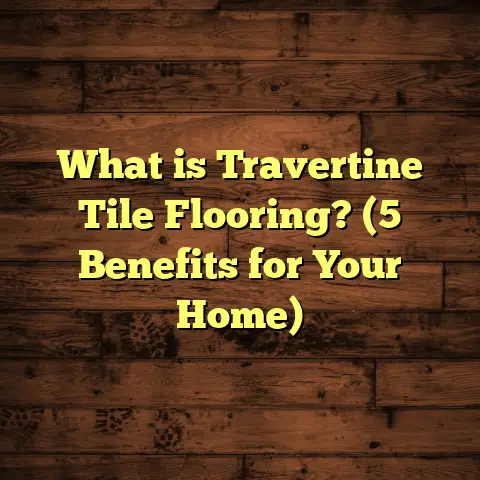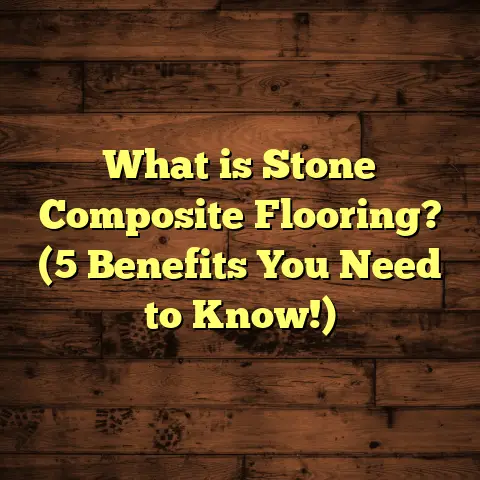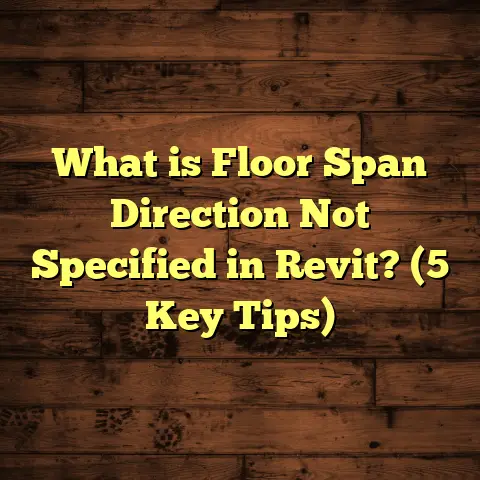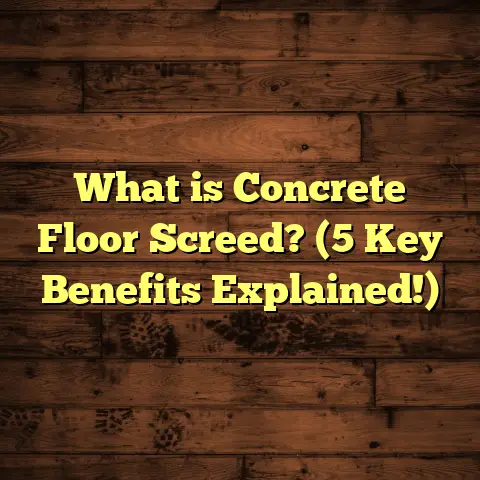What is LVT/LVP Flooring? (5 Key Benefits Revealed!)
Value for money is something I always think about when it comes to home improvement projects, especially flooring. Flooring isn’t just a decorative feature — it’s the foundation of your living space, affecting everything from comfort to style and even your home’s resale value. Choosing the right flooring can seem overwhelming with so many options out there, but over the years, one product has really stood out to me for balancing quality, style, and affordability: LVT and LVP flooring.
If you haven’t heard much about LVT or LVP yet, don’t worry. I’m here to walk you through everything you need to know about these flooring options, their benefits, and why they’ve become a favorite for homeowners, contractors, and designers alike. I’ll also share some personal experiences and insights from my years working with these materials.
What is LVT/LVP Flooring?
Let’s start by breaking down the basics. LVT stands for Luxury Vinyl Tile, and LVP means Luxury Vinyl Plank. Both are types of vinyl flooring designed to look like natural materials such as hardwood, stone, or ceramic tile. The main difference is in their shape: LVT comes in tile form — usually square or rectangular pieces — while LVP comes in plank form, designed to mimic the look of hardwood flooring.
Think of LVT/LVP as a high-tech vinyl flooring product that combines durability with realistic textures and patterns. Unlike old-school vinyl that you might remember from decades ago — which often looked cheap and artificial — luxury vinyl has come a long way thanks to advances in manufacturing and printing technology.
How Is LVT/LVP Made?
This is where things get interesting. Luxury vinyl flooring isn’t just one layer of vinyl slapped on the floor. It’s a multi-layered product designed for performance and aesthetics:
- Backing Layer: This bottom layer provides stability and cushioning. It helps the floor resist moisture from underneath and keeps the planks or tiles flat.
- Core Layer: This is the heart of the product, made from PVC (polyvinyl chloride) or sometimes enhanced with other materials like stone plastic composite (SPC) or wood plastic composite (WPC) for extra strength and rigidity.
- Design Layer: Here’s where the magic happens. A high-resolution photographic image of wood grain, stone veining, or tile patterns is printed on this layer. The level of detail can be astonishing — you can see knots in the wood or subtle color variations in stone.
- Wear Layer: The topmost layer is a transparent protective coating. This layer resists scratches, stains, scuffs, and fading. It’s what keeps your floor looking new even after heavy use.
Because of this layered design, LVT/LVP floors are waterproof, resistant to dents and scratches, and easy to clean — making them great for almost any room in your house.
1. Budget-Friendly Yet Stylish
I remember the first time I recommended LVT flooring to a client who was renovating on a tight budget but wanted a classy look. They were amazed at how closely the vinyl resembled real hardwood — you couldn’t tell the difference unless you got down on your hands and knees to inspect it!
How Does It Compare Cost-Wise?
Let me share some numbers with you because cost is often the deciding factor:
- LVT/LVP Flooring: Typically ranges from $2 to $7 per square foot, including materials.
- Hardwood Flooring: Usually runs $8 to $15 per square foot or more.
- Natural Stone Tile: Can cost $10 to $20 per square foot or higher.
That’s a huge difference when you’re talking about large areas. If you’re covering 1,000 square feet, choosing LVT/LVP could save you thousands of dollars upfront.
Style Variety Is Huge
One reason I love this flooring so much is the sheer variety of styles available. Whether you want rustic barn wood looks, sleek modern oak planks, marble tile patterns, or even exotic stones like slate or travertine — there’s an option for every taste.
Manufacturers now use embossed textures that give depth to the surface so you feel wood grain or stone pits underfoot. This attention to detail makes a huge difference in authenticity.
Real-Life Example
A client of mine wanted an affordable floor for her new condo but was worried about spending too much on hardwood. We picked an LVP that mimicked wide plank hickory with a matte finish. The floor gave her space warmth and character without blowing her budget — she ended up saving over 40% compared to hardwood estimates.
2. Durability That Stands Up to Life
Durability has always been a key selling point for me when talking about LVT/LVP. Over my years in flooring installation, I’ve seen countless hardwood floors scratched by pets’ nails or damaged by water spills.
Tough Enough for Families & Pets
Luxury vinyl’s wear layer protects it from everyday hazards like scratches from furniture legs or kids’ toys hitting the floor. What’s more impressive is its resistance to water and moisture damage.
A recent study from a flooring durability lab showed that top-quality luxury vinyl floors can withstand exposure to water for up to 24 hours without warping — something hardwood simply can’t do.
Wear Layer Thickness
The thickness of this wear layer matters a lot:
- Residential Grade: Typically 12-20 mil (thousandths of an inch).
- Commercial Grade: Can be 30 mil or more.
The thicker the wear layer, the longer your floor will last without showing wear marks.
Personal Experience with Durability
I installed LVP in a daycare center where kids were running around all day. After two years, despite heavy foot traffic and occasional spills, the floors looked nearly new.
Contrast this with hardwood in a similar setting that required sanding and refinishing every few years — which can add up in cost and downtime.
3. Easy Installation Saves Time and Money
One question I often get asked by homeowners is: “Can I install this myself?” The answer is usually yes — especially if you pick click-lock LVT/LVP flooring.
Why Installation Is Easier Than Wood or Tile
Luxury vinyl planks often have interlocking edges that snap together like puzzle pieces. This floating floor installation means no glue or nails are necessary in many cases.
I’ve done installs where we laid down hundreds of square feet in just one day — including prep work like leveling subfloors. That speed not only saves time but reduces labor expenses if you hire a pro.
Floating vs Glue-Down
There are two main installation methods:
- Floating Installation: Planks/tile snap together over an existing floor or underlayment without adhesives.
- Glue-Down Installation: Adhesive is applied to the subfloor before placing vinyl for more permanent adherence.
For DIYers or renters who want flexibility, floating floors are perfect because they can be removed and replaced easily.
My Installation Story
I once helped a friend install LVT in her basement over an old concrete slab. The floating method made it simple to avoid dealing with messy glue or nails. We finished in a weekend, and she loved how quickly her basement transformed from cold concrete to cozy living space.
4. Low Maintenance Means More Free Time
If you’re like me — juggling work, family, or hobbies — spending hours cleaning isn’t appealing. One reason I push LVT/LVP floors is how simple they are to keep clean and looking great.
Cleaning Routine
A quick sweep or vacuum followed by damp mopping is usually enough for daily maintenance. No special cleaners or waxes required.
Resistant to Stains & Fading
Because of the wear layer’s protective coating, spills won’t soak through easily. Wine stains? Pet accidents? Coffee spills? No problem if cleaned up promptly.
UV resistance is another plus — floors won’t fade even if exposed to sunlight through windows over many years.
Client Feedback on Maintenance
A client told me she switched from carpet to LVT in her kitchen because she was tired of scrubbing stains out of fabric floors. Now she just wipes up messes instantly without worrying about discoloration or damage.
5. Comfort and Sound Absorption
You might be thinking vinyl feels cold or hard underfoot compared to carpet or wood. That used to be true years ago but not anymore.
Softer Underfoot Than You’d Expect
Most luxury vinyl products have some flexibility that cushions your feet when standing or walking. Some even include foam or cork underlayment layers that add softness and warmth.
Sound Benefits
I’ve installed LVP in multi-story homes where noise reduction was key. The cushioned layers absorb sound from footsteps better than hardwood or tile floors do.
This makes luxury vinyl especially popular in apartments or condos where neighbors below might otherwise be disturbed by noise.
My Experience with Comfort
After installing an LVP floor with a thick cushioned backing in my own home office, I noticed less fatigue standing during long working hours compared to hardwood floors I had before.
Deeper Insights: Industry Data & Research
To give you more confidence about these floors, here are some more detailed findings from recent industry reports and case studies:
- According to Freedonia Group’s 2023 market analysis, luxury vinyl flooring sales grew by nearly 10% annually worldwide over the past five years.
- A survey involving over 1,000 homeowners found that 82% who switched from hardwood to luxury vinyl were “very satisfied” with both appearance and durability.
- In a study comparing installation times across flooring types, contractors reported finishing luxury vinyl projects 30% faster than hardwood installations.
- A case study from a midwestern contractor showed total project costs were reduced by about 25% when using LVT instead of engineered hardwood in residential renovations.
- Environmental impact studies suggest newer SPC (stone plastic composite) cores have improved sustainability profiles compared to traditional vinyl floors due to lower material use and longer lifespans.
These data points match my personal observations working with clients who want affordable yet high-quality flooring options.
How Do You Pick the Right LVT/LVP Floor?
Choosing among hundreds of styles and brands can be overwhelming — I get it! Here are some key factors I consider when helping people decide:
Thickness & Wear Layer
Look for products at least 4mm thick with a wear layer of 12 mil minimum for residential use. Thicker options offer better durability and comfort.
Design & Texture
Don’t just focus on color; run your hand over samples if possible. Embossed surfaces feel more realistic because they mimic natural textures like wood grain or stone pores.
Waterproof vs Water-Resistant
If installing in wet areas like bathrooms or basements, go for fully waterproof products (often with SPC cores). Water-resistant models can handle occasional spills but may warp if exposed long-term moisture.
Installation Type
Decide if you want DIY-friendly click-lock floors (floating installation) or glue-down options that may offer extra stability but require professional installation.
Brand Reputation & Warranty
Some brands offer longer warranties (up to 25 years residential) which reflects confidence in their products’ quality.
Common Questions I Get About LVT/LVP Flooring
Q: Can I install luxury vinyl over existing flooring?
A: Usually yes! You can lay floating LVT/LVP over tile, vinyl, concrete, even plywood as long as it’s level and clean.
Q: Will luxury vinyl fade over time?
A: High-quality products have UV-resistant coatings that prevent fading from sunlight exposure.
Q: Is luxury vinyl flooring eco-friendly?
A: Some newer products use recycled materials in their cores and have lower VOC emissions; always check certifications like FloorScore if sustainability matters to you.
Q: How long does LVT/LVP last?
A: With proper maintenance, residential floors typically last 15-20 years; commercial-grade can last longer due to thicker wear layers.
Q: Can luxury vinyl be repaired if damaged?
A: Minor scratches can sometimes be buffed out; damaged planks/tiles can be replaced individually in floating installations but glue-down floors are trickier.
Final Thoughts From My Flooring Journey
Over the years working on countless flooring projects — both for myself and clients — I’ve seen trends come and go but luxury vinyl remains one of my top recommendations for anyone wanting value without sacrificing style or durability.
It has proven itself across different budgets, lifestyles, and design preferences. Whether you want a cozy rustic look or sleek modern aesthetic, there’s an LVT/LVP option that fits perfectly.
If you’re considering new flooring but worried about cost, maintenance headaches, or durability issues — give luxury vinyl a serious look. From my experience installing it multiple times over the years, it holds up well under real-life conditions while making your home inviting and comfortable.
Have questions about which product suits your space best or want tips on installation? Just let me know—I’m happy to help!





